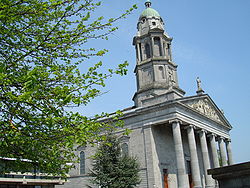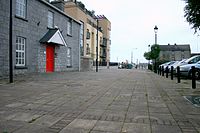Longford
| Longford Irish: An Longfort | |
| County Longford | |
|---|---|
 Longford Cathedral | |
| Location | |
| Grid reference: | N135750 |
| Location: | 53°43’37"N, 7°47’59"W |
| Data | |
| Population: | 9,601 (2011) |
| Local Government | |
| Website: | http://www.longfordcoco.ie |
Longford is the county town of County Longford. It had a population of 9,601 according to the 2011 census. It is the biggest town in the county and about one third of the county's population lives there. Longford lies at the meeting of the N4 and the N5 primary routes, which means that traffic travelling between Dublin and County Mayo or North County Roscommon passes through the town.
History
The town is built on the banks of the River Camlin (Irish Camlinn, meaning "crooked pool"), which is a tributary of the River Shannon. The name Longford is from the Old Norse Langfjord meaning "Long lake", referring to Loch Ree, though others claim an Irish-language Longphort, meaning "ship port", a word first used in Irish annals to describe Norse ship bases. Vikings were certainly here, and the annals refer to the King of Limerick having ships on Loch Ree.
The area came under the sway of the local clan which controlled the south and middle of the County of Longford (historically called Anghaile) and hence, the town is sometimes called Longphort Uí Fhearghail (port of O'Farrell).
A Dominican priory was founded at Longford in 1400.
Places of interest
The Corlea Trackway Visitor Centre is located near to Longford, in Keenagh. The Centre houses an Iron Age bog road which was built in 148 BC across the boglands in proximity to the River Shannon. The oak road is the largest of its kind to have been uncovered in Europe and was excavated over the years by Professor Barry Raftery of University College Dublin. Inside the building, an 20-yard stretch of preserved road is on permanent display in a specially designed hall with humidifiers to prevent the ancient wood from cracking in the heat. Bord na Mona and the Heritage Service have carried out conservation work on the surrounding bog to ensure that it remains wet and that the buried road is preserved. There are other historical artefacts and some exhibits at the centre.
St Mel's Cathedral in the town features several stained glass windows by Harry Clarke studios. These include one of his earliest works The consecration of St Mel as Bishop of Longford which was exhibited at the RDS Annual Art Industries Exhibition in 1910, where it received second prize. It was also exhibited at The Arts and Crafts Society of Ireland fourth exhibition in the same year. The Cathedral was extensively damaged in a fire on Christmas Day 2009. The two most intricate stained-glass windows in the transepts of the Cathedral it seems will be able to be restored - these depict St Anne and the Resurrection.
Longford town boasts a state-of-the-art 200-seat theatre, and a four-screen multiplex cinema, with restaurants. The mix and quality of housing is extensive and the Rural Renewal Hi Scheme (1999–2006) has ensured that a steady supply of residential development has come about. Longford town has a decentralised government department which employs approximately 300 people with plans for a further 160 to be employed at the Irish Prison Service's new headquarters in the Lisamuck area of the town. Longford's local army barracks once employed approximately 180 soldiers, many of whom were involved in UN peace-keeping duties. However, the barracks closed at the end of January 2009 as part of government cutbacks in military spending. The personnel have been transferred to Athlone.
The town serves as the cathedral town of the Roman Catholic Diocese of Ardagh and Clonmacnoise. St Mel's Cathedral,[1] dedicated to Saint Mel, the founder of the diocese of Ardagh, was designed by architect John Benjamin Keane, who also designed St Francis Xavier's Church on Gardiner Street in Dublin. On Christmas morning of 2009, the cathedral was severely damaged as the result of a fire.[2]
There are a number of portal dolmens located around Longford.
Economy

Longford's main industries are food production, sawmills, steelworking, generator retailing, cable making and the production of medical diagnostics. It is the major services centre for the county as well as the location of the Department of Social Welfare and the Irish Prison Service. The town is also a local commercial centre, with many retail outlets including multiples.
Up until 2007, construction was a major local employer, mainly due to government tax breaks for property development provided under the Rural Renewal scheme. However the downturn in the construction industry, the withdrawal of Rural Renewal, and extensive local oversupply of property has caused large job losses in the construction industry and a significant increase in unemployment in the region.
Outside links
- Topographical Dictionary of Ireland by Samuel Lewis
- Info on St Mel's Cathedral before and after the fire
- Irish Rail Longford Station
References
| ("Wikimedia Commons" has material about Longford) |
- ↑ "St Mels Cathedral, Longford, Ireland, Diocese of Ardagh and Clonmacnois, Cathedral Fire, Friends of St Mels Cathedral". Stmelscathedral.com. 2009-12-25. http://www.stmelscathedral.com. Retrieved 2012-06-23.
- ↑ "RTÉ News: Longford Cathedral gutted in fire". 2009-12-25. http://www.rte.ie/news/2009/1225/longford.html. Retrieved 2009-12-25.
